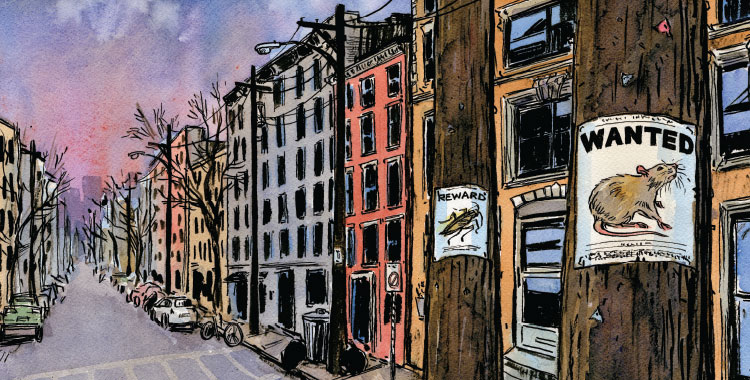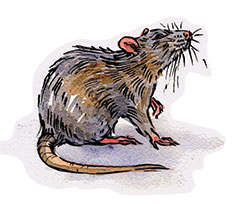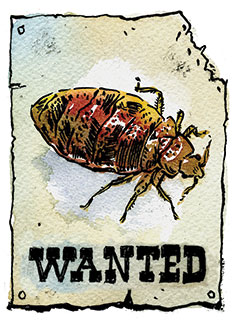America’s urban landscapes have long been a battleground in wars against bedbugs, roaches, rats and flies. In a new book, UMBC professor Dawn Biehler traces that conflict’s history across boundaries of class and race.
By Richard Byrne ’86
Illustrations by Joanna Barnum
Most city dwellers feel nothing but loathing and fear when they see the rats and roaches that often plague their neighborhoods. And even visitors to the big city can panic when bedbugs infest their hotel beds.
So what sort of researcher likes to dig into the vexed dynamics of our interactions with such pests? Dawn Biehler, an assistant professor of geography and environmental systems at UMBC, says it helps to have strong (and early) curiosity about things that might turn a normal person’s stomach.
“I’ve always really liked disgusting things,” says Biehler. “Going back to age eight or so, I was interested in outbreaks of bubonic plague. The Black Death in Europe and Asia.”
After college, Biehler’s participation in Volunteers in Service to America (VISTA) led her to take a strong interest in housing issues. “I was interested not just in whether people had housing,” she recalls. “But also what was the quality of the housing that they lived in.”
Those overlapping interests in creatures, health and social justice laid the foundation for her current academic research and a new book, Pests in the City: Flies, Bedbugs, Cockroaches, and Rats, which will be published by the University of Washington Press this autumn.
Using sources that range from old public health records to yellowing housekeeping manuals to episodes of the NBC sitcom 30 Rock, Pests in the City is a history of 20th century efforts to eradicate these bugs and rodents in American cities (including Baltimore) that takes in culture, biology and ecology. Biehler not only traces how these campaigns were often hampered or thwarted by societal divisions of class and race, but also how the battle to rid urban landscapes of pests blurs the traditional (and often divisive) boundaries of public and private space.
“Pests are both public and private,” Biehler explains. “They upset this very neat dividing line between our homes and the rest of the world.”
Biehler also demonstrates how the battles to eliminate rats and roaches became focal points for political organizing in the 1960s and 1970s, including tenants in public housing (where neglect and proximity of residences often led to the proliferation of pests) who united behind demands for cleaner and safer environments in which to live.
“Dawn’s research offers compelling insights into the construction of urban ecologies,” observes Sandy Parker, chair of the geography and environmental systems department. “Her use of political ecology, environmental history, and health geography opens up new ways of thinking about urban health and urban environments.”
THE POWER OF PERSISTENCE
Pests in the City deftly sketches a century of America’s urban combat with pests. But one of Biehler’s most interesting gambits in the book is to occasionally step out of human history and view the urban landscape as the pests saw it before and after public campaigns launched to eradicate them.
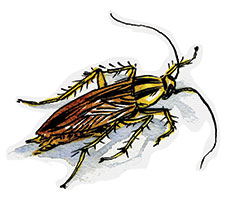 Biehler begins the chapter on attempts to eliminate German cockroaches, for instance, with a vivid roach’s eye view circa 1946, before powerful pesticides to attempt to control them were in wide use:
Biehler begins the chapter on attempts to eliminate German cockroaches, for instance, with a vivid roach’s eye view circa 1946, before powerful pesticides to attempt to control them were in wide use:
On the dry-good shelf at the market, a Blattella germanica left a sticky ootheca, one of eight she would lay in her lifetime, clinging to a sack of rice. The shopper did not see the purse-shaped egg-case, smaller than a pea, as she lifted the sack from the shelf, nor did she see it later while packing her groceries. German cockroaches already infested her New York apartment building so thoroughly that she would never notice the new brood she brought home.
“People don’t do that in history books very much,” Biehler says of these vignettes, which she developed after consultations with editors at University of Washington Press.
Writing the book also forced Biehler to get to grips with the biology of the pests that she was writing about. “I was pretty naïve about all of these pests going in,” she says. But trips to the field with exterminators and delving into current research helped fill in the gaps and understand how German cockroaches not only modify their behavior to adapt to changes in home environments, but also develop biological resistance to certain pesticides.
“Cockroaches’ behavior is very plastic,” Biehler says. “And their genetics are very plastic. These cockroaches are changing themselves in two different ways to adapt.”
Biehler’s adoption of the pests’ eye view underscores the persistence of these creatures despite immense efforts to eradicate them. (Indeed, in the cases of rats and roaches, some efforts have had unintended consequences that enhance their survival.)
Yet public campaigns to eradicate pests did help change perceptions. Flies, for instance, once were thought to be more or less harmless. But more importantly, technology and social engineering were also changing the environment in which pests bred – for better and for worse.
The radical shift in the early 20th century from horses to the motor engine as a primary means of transportation virtually eliminated the stables in urban centers where flies found their best environment for breeding.
Other pests, however, proved more difficult to control, let alone eradicate. Biehler observes that bedbugs were such a problem in the early 20th century that those afflicted were willing to eradicate them with deadly prussic acid (HCN), which triggered numerous sudden accidental deaths when applied in homes under less than optimal conditions.
“Part of the strangeness of that risk is the suddenness of it,” Biehler says. “HCN was so quick and so absolute. That’s what makes it distinct from the risks we assume today, which tend to be long term and cumulative.”
Biehler also closely examines the mixed success of large-scale campaigns (centered at The Johns Hopkins University) to help Baltimore better control its rat population in the 1940s.
Curt Richter, a physiologist at the university’s medical school, developed a new chemical (ANTU) that would escape detection by the rats and also kill them. But the attempts to implement its widespread use in the city created health, environmental, and political concerns. A separate effort by ecologists to tackle the rat problem soon after via intensive block-by-block eradication a few years later eventually flagged after an auspicious start – and the ecologists also failed to adequately address rats’ penetration into neighborhood homes and public spaces.
Baltimore’s efforts “didn’t include the community that well,” Biehler observes. “African-American communities in Baltimore had been doing all these cleanup activities for decades. It was really a lost opportunity to take advantage of that sustained community effort for ecological rat control.”
BITES AND RIGHTS
Biehler doesn’t ignore the cultural implications of pestilence. From Richard Wright’s Native Son to public information campaigns by the Black Panther Party, she observes that writers and artists have used images of urban residents battling infestation to express wider political and cultural dissent.
And the persistence of urban infestation became an even more powerful image when contrasted against the progress made elsewhere in society, notes Biehler, who quotes a biting passage from Gil Scott-Heron’s 1970 song “Whitey on the Moon”: “Rat done bit my sister Nell/ (with Whitey on the moon)/ Her face and arms began to swell/ (and Whitey’s on the moon).”
“Not many historians have focused on the fact that [Rachel Carson’s ecological classic] Silent Spring and the Civil Rights era overlapped with one another,” she says. “Both point to problems of modernity, and how the promises of modernity have failed… and especially, with the Civil Rights movements, that modernity has not worked for us in particular ways.”
Pests in the City also traces how communities organized not only to rid themselves of pests but also to put pressure on politicians. Biehler traces this struggle through the pages of African-American newspapers, excavating the work of activists such as Jesse Gray, who successfully organized city residents around pest control issues in New York City in the 1970s. The tide was shifting, Biehler finds, and the shame associated with infestation was being transformed into rage and fueling attempts to reclaim both private property held by slumlords and public housing from squalor.
Not that it was easy. At times, efforts to pressure the government for help in resolving these problems ran aground on rural and urban divides. Biehler recalls that rural members of the U.S. Congress not only killed legislation to fund rat control in afflicted areas, but openly mocked it – in essence blaming city residents for their own infestations. One legislator, she writes, stated on the floor of the House of Representatives that “the rat smart thing to do is to vote down this civil rats bill, rat now.”
What brings Biehler’s history into sharp contemporary focus is the realization that infestations can and do cross lines of race and class to unite all citizens in the suffering and shame – as has happened more than once since 2000 when new epidemics of bedbugs spread quickly in urban areas. These outbreaks infested fancy hotels as well as city homes, and served as a reminder of how pests can alter our reality.
TAKING IT TO THE STREETS
Biehler’s research and teaching also track more contemporary ripples from this ongoing conflict between pests and humans. She is also examining an urban nuisance not tackled in her book: mosquitoes.
As part of an ongoing research project started in Washington, D.C., and now working in Baltimore neighborhoods, Biehler is assessing the attitudes and knowledge of city residents about mosquito infestation in Baltimore. (The project is a collaboration with researchers at the Baltimore Ecosystem Study, Rutgers University, the Parks and People Foundation, and the University of Maryland, College Park and it has received multiyear funding from the National Science Foundation.)
Because effective mosquito prevention requires an understanding of how and where the insects breed, informed and proactive residents can play a key role in efforts to control them. Biehler is also trying to understand how mosquitoes change people’s environments as well. “I’m asking about how mosquitoes are changing people’s use of space,” she says. “Indoor and outdoor space. How can mosquitoes be unifiers or dividers in a neighborhood?”
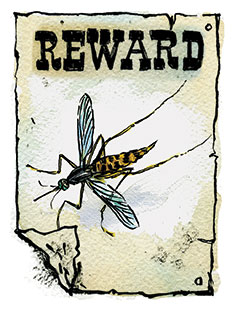 The same questions of public and private space that Biehler tackles in Pests in the City also crop up in the mosquito research. “On the one hand, people agree that we need to work together to control mosquitoes when there is something in the landscape that supports breeding,” she observes. “On the other hand, sometimes neighbors get mad when they feel that one neighbor isn’t doing enough, which places a stigma or an ongoing grudge. And then [we ask] how that affects mosquito management.”
The same questions of public and private space that Biehler tackles in Pests in the City also crop up in the mosquito research. “On the one hand, people agree that we need to work together to control mosquitoes when there is something in the landscape that supports breeding,” she observes. “On the other hand, sometimes neighbors get mad when they feel that one neighbor isn’t doing enough, which places a stigma or an ongoing grudge. And then [we ask] how that affects mosquito management.”
Sandy Parker says that Biehler’s research “will become even more important in the context of climate change, changing urban ecologies, and the spread of pathogens and insect-borne diseases.” He adds that the outreach to citizens at the heart of the effort “provides a voice to the experiences of those living within these communities,” and that Biehler herself “offers valuable historical information that community-based organizations can use in constructing their own strategic initiatives.”
Indeed, with help from other scholars in science education and environmental justice, Biehler is expanding the study into a “citizen science project” that will encourage residents not only to help eliminate harbors in which mosquitoes can breed, but to become part of the process of discovery.
Biehler also brings her research into the classroom at UMBC, enlisting students in a new class that she has developed on environmental justice as part of the citizen science effort. The students have partnered with a youth group at St. Luke’s Episcopal Church in Baltimore’s Franklin Square neighborhood.
“I want the students to develop an understanding of what it’s like living in an environment where there has been disinvestment for a significant period of time,” she says.
Ultimately, Biehler’s research aims to transform the pests that infest our homes and environments into teachers, casting new light on the world around us. “These animals have learned much from humans, our cities and our homes” she writes in Pests in the City. “The persistence of unjust urban environments raises the question of whether we have learned from them.”

